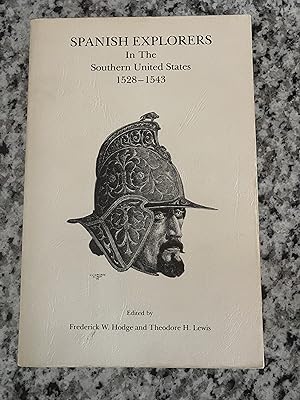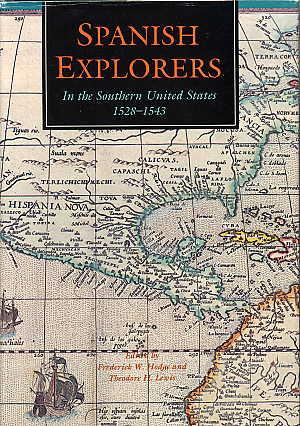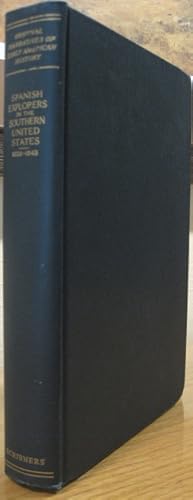hodge frederick theodore lewis editors (5 résultats)
Type d'article
- Tous les types d'articles
- Livres (5)
- Magazines & Périodiques
- Bandes dessinées
- Partitions de musique
- Art, Affiches et Gravures
- Photographies
- Cartes
-
Manuscrits &
Papiers anciens
Etat
- Tous
- Neuf
- Ancien ou d'occasion
Reliure
Particularités
- Edition originale (3)
- Signé
- Jaquette (3)
- Avec images (3)
- Sans impression à la demande
Pays
Evaluation du vendeur
-
Spanish Explorers in the Southern United States, 1528-1543
Edité par Texas State Historical Assn, Austin, Texas, 1984
ISBN 10 : 0876110677ISBN 13 : 9780876110676
Vendeur : TribalBooks, Dallas, TX, Etats-Unis
Livre
Soft cover. Etat : Very Good. Illustrated wraps, 411 pp, frontis, fold-out maps, index. Private library card pocket to rear of front wrap, owner name ink stamp to front fly and TEP, light age-darkened wraps. Shelf D2.
-
Spanish Explorers in the Southern United States, 1528-1543.
Edité par Texas State Historical Association,, Austin:, 1985
ISBN 10 : 0876110669ISBN 13 : 9780876110669
Vendeur : Grendel Books, ABAA/ILAB, Springfield, MA, Etats-Unis
Livre Edition originale
Hardcover. Etat : As New. Etat de la jaquette : As New. First edition thus. As new in like dust jacket. Still in original shrinkwrap.
-
Spanish Explorers in the Southern United States 1528-1543.
Edité par The Texas Historical Association, Austin, TX., 1990
ISBN 10 : 0876110669ISBN 13 : 9780876110669
Vendeur : Quinn & Davis Booksellers, Austin, TX, Etats-Unis
Livre
Hardcover. Etat : As New. Etat de la jaquette : As New. Second printing First by this publisher. A facsimile of the classic 1907 edition. Includes a facsimile of , THE NARRATIVE OF ALVAR NUNEZ CABECA DE VACA, edited by Frederick W. Hodge; THE NARRATIVE OF THE EXPEDITION OF HERNANDO DE SOTO BY THE GENTLEMAN OF ELVAS, edited by Theodore H. Lewis; and THE NARRATIVE OF THE EXPEDITION OF CORONADO, BY PEDRO DE CASTANEDA, edited by Frederick W. Hodge. 411 pages. The two fold out maps are present in this volume. Dust jacket and book are in Fine, as new, condition. ; Standard Book Size.
-
Spanish Explorers in the Southern United States 1528-1543
Edité par Charles Scribner's Sons, New York, 1907
Vendeur : K & B Books, Tucson, AZ, AZ, Etats-Unis
Livre Edition originale
Hardcover. Etat : Fine. No Jacket. 1st Edition. 411 pp., facsimile frontis, two fold-out maps, index. A fine, tight, unmarked copy with a discreet previous owner signature on the ffep. This comprehensive, academic volume is comprised of the narrative of Alvar Nunez Cabeca De Vaca, the narrative of the expedition of Hernando De Soto by gentleman of Elvas, and the narrative of the expedition of Coronado, by Pedro De Castneda.
-
Spanish Explorers in the Southern United States 1528-1543; The Narrative of Alvar Nunez Cabeca de Vaca, The Narrative of the Expedition of Hernando de Soto by the Gentleman of Elvas, and The Narrative of the Expedition of Coronado, by Pedro de Castaneda
Edité par Barnes & Noble, Inc, New York, 1959
Vendeur : Ground Zero Books, Ltd., Silver Spring, MD, Etats-Unis
Edition originale
Hardcover. Etat : Good. Etat de la jaquette : Fair. xiii, [3], 413, [3] pages. Footnotes. Index. Some endpaper and edge soiling. DJ is worn, torn, soiled and chipped. This is par of the Original Narratives of Early American History produced under the auspices of the American Historical Association under the General Editorship of J. Franklin Jameson. The three narratives printed in this book are but a small selection from among many scores; for the narratives of Spanish explorers in the southern United States constitute an extensive literature. But if interest and historical importance are both taken into account, it is believed that these three hold an undisputed preeminence among such 'relations.' Frederick Webb Hodge (October 28, 1864 - September 28, 1956) was an American editor, anthropologist, archaeologist, and historian. He graduated from Cambridge College (now George Washington University). He became very interested in Native American history and cultures, and worked for the Bureau of American Ethnology from 1905 to 1918. He collaborated with George Gustav Heye, who had been collecting Native American artifacts, and established the Heye Foundation to support archeological work. Heye founded the Museum of the American Indian in 1916 in New York, where Hodge later served as editor and assistant director. During his time at the Smithsonian, Hodge also conducted archeological expeditions and excavations at Nacoochee Mound in Georgia, and at Hawikuh, near Zuni Pueblo. He also served as executive officer at the Smithsonian Institution. Theodore Hayes Lewis was the first archaeologist to systematically survey and record archaeological sites in Minnesota. He was born in 1856 and disappeared in Colorado in 1909. He was educated in Ohio and moved to St. Paul, Minnesota in 1878 where he worked as a surveyor investigating antiquities from 1878-1880. He began work on the Northwestern Archaeological Survey during the years 1880-1883 and became associated with Alfred J. Hill in 1881, who paid most of his research expenses and contracted with Lewis to complete a survey of Native American burial mounds in Minnesota and other nearby states. Between 1883 and 1895 Lewis surveyed more than 12,000 mounds in Minnesota, Canada and surrounding states. From 1884 to 1907, he published over 50 scholarly articles about his research in Minnesota, which have formed the basis of knowledge about petroglyphs, incised boulders, burial mounds and cave art in the state. Álvar Núñez Cabeza de Vaca (c. 1488/90/92 - after 19 May 1559) was a Spanish explorer of the New World, and one of four survivors of the 1527 Narváez expedition. During eight years of traveling across what is now the US Southwest, he became a trader and faith healer to various Native American tribes before reconnecting with Spanish civilization in Mexico in 1536. After returning to Spain in 1537, he wrote an account, first published in 1542 as La relación y comentarios ("The Account and Commentaries"). Cabeza de Vaca is sometimes considered a proto-anthropologist for his detailed accounts of the many tribes of Native Americans that he encountered. Hernando de Soto (c. 1500 - 21 May 1542) was a Spanish explorer and conquistador who was involved in expeditions in Nicaragua and the Yucatan Peninsula. He played an important role in Francisco Pizarro's conquest of the Inca Empire in Peru, but is best known for leading the first European expedition deep into the territory of the modern-day United States (through Florida, Georgia, Alabama, Mississippi, and most likely Arkansas). He is the first European documented as having crossed the Mississippi River. De Soto's North American expedition was a vast undertaking. It ranged throughout what is now the southeastern United States, both searching for gold, which had been reported by various Native American tribes and earlier coastal explorers, and for a passage to China or the Pacific coast. De Soto died in 1542 on the banks of the Mississippi River; different sources disagree on the exact location, whether it was what is now Lake Village, Arkansas, or Ferriday, Louisiana. The first account of the expedition to be published was by the Gentleman of Elvas, an otherwise unidentified Portuguese knight who was a member of the expedition. His chronicle was first published in 1557. An English translation by Richard Hakluyt was published in 1609. Pedro De Castaneda was a chronicler of the Coronado Expedition to Quivira in 1540-42. Castaneda was a native of the Biscayan town of Najera in Spain. He came to the Americas before the middle of the 16th century and became prominently identified with Mexico's government and affairs. He lived in the Mexican town of Culiacan from which the expedition set out, at which time he was listed on the muster roll as departing with two horses, one coat of mail, and "native weapons." His Coronado Expedition account was first written in Mexico soon after the event, but the original manuscript has disappeared. After returning to Spain, Castaneda made a copy, which was finished on October 26, 1596. His narrative was not published but remained in the archives until translated first to French and then to English. The Spanish manuscript, now in the Lenox Library in New York, was translated into English by George P. Winship, assistant in American History at Harvard University. His translation was published in the 14th annual report of the United States Bureau of Ethnology. Castaneda's account ranks with the log of Christopher Columbus and De Soto's expedition as one of the most important documents on the early European exploration of North America. Reprint edition. Presumed first printing thus.






